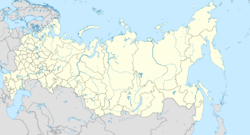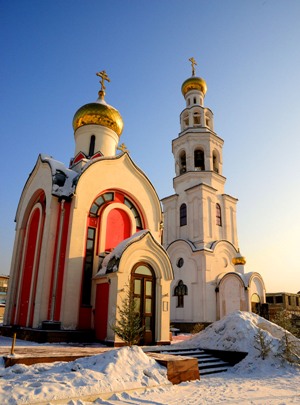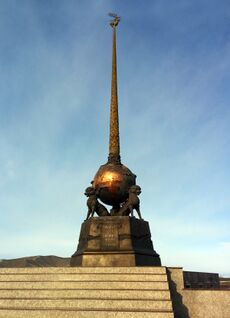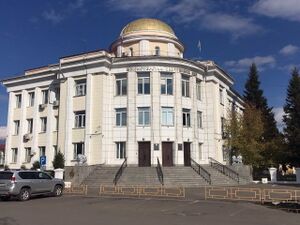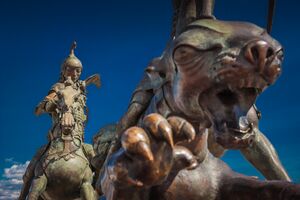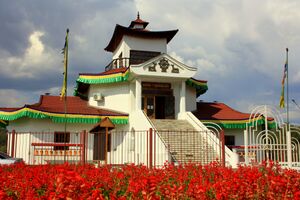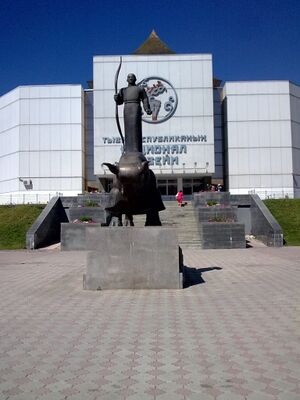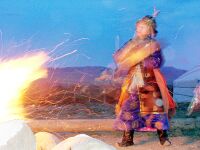كيزيل
{{ safesubst:#invoke:Unsubst||date=__DATE__|$B=
قزل
Кызыл | |
|---|---|
| الترجمة اللفظية بالـ Other | |
| • Tuvan | Кызыл |
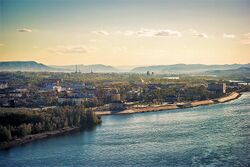 منظر قزل | |
أظهر Location of قزل | |
| الإحداثيات: 51°43′N 94°27′E / 51.717°N 94.450°E | |
| البلد | روسيا |
| الكيان الاتحادي | Tuva[1] |
| Founded | 1914 |
| City status since | 1914 |
| الحكومة | |
| • Mayor | Karim Baylak-oolovich Sagaan-ool |
| المنسوب | 630 m (2٬070 ft) |
| التعداد | |
| • الإجمالي | 109٬918 |
| • Estimate (2018) | 116٬983 (+6٫4%) |
| • الترتيب | 146th in 2010 |
| • Subordinated to | city under republic jurisdiction (urban okrug) of Kyzyl[1] |
| • Capital of | Tuva[1] |
| • Capital of | city under republic jurisdiction (urban okrug) of Kyzyl[1] |
| • Urban okrug | Kyzyl Urban Okrug[3] |
| • Capital of | Kyzyl Urban Okrug[3] |
| منطقة التوقيت | UTC+ ([4]) |
| Postal code(s)[5] | 667000–667005, 667007–667012, 667700, 667899, 667961, 667965, 667966, 667970, 667999 |
| Dialing code(s) | +7 39422 |
| OKTMO ID | 93701000001 |
| الموقع الإلكتروني | mkyzyl |
Kyzyl ( /kɪˈzɪl/; روسية: Кызыл, النطق الروسي: [kɨˈzɨɫ]; توڤا: Кызыл, Kızıl, tyv, ) is the capital city of the republic of Tuva, Russia. The name of the city means "red" or "crimson" in Tuvan (and in many other Turkic languages). Its population was 120٬067 (تعداد 2021)؛[6]
التاريخ
The city was founded in 1914 as Belotsarsk (روسية: Белоцарск, تـُنطق [bʲɪɫɐˈt͡sarsk]; "White Tsar's town").[7] In 1918, it was renamed Hem-Beldir (توڤا: Хем-Белдир, tyv). In 1926 it was given its present name.[بحاجة لمصدر] When the city was the capital of Tannu Tuva, it was named Kizil Khoto. In September 2014, Kyzyl celebrated its 100th anniversary as a city.
| Years | Titles | Affiliation |
|---|---|---|
| 1914–1917 | Belotsarsk | Uryankhay Krai (protectorate of the Russian Empire) |
| 1921–1944 | Hem-Beldyr, Kyzyl | قالب:Country data Tuvan People's Republic (partially recognized state) |
| 1944–1991 | Kyzyl | |
| since 1991 |
The settlement was founded in 1914 by Russian settlers immediately after the entry of the then Uryankhay Krai under the protectorate of the Russian Empire called Belotsarsk .
In the center of the Uryankhay region, at the confluence of the two Yenisei, the Big and Small, on a large elevated plain, I have designed the administrative center of the region, the future city of Belottsarsk. This name was given in honor of the Sovereign Leader of the Russian people, known to the Uryankhs under the name "Tsagan-Khan", which means White Tsar ...
— Vladimir Gabaev, head of the Russian population in Tuva [8]
In 1918, in connection with the revolution and the antimonarchist movement, it was renamed to Khem-Beldyr, and in 1926 to Kyzyl (Tuv .: red).
In 1921–1944, the city was the capital of Tuvan People's Republic, from 1944 to 1961 the capital of the RSFSR's Tuvan Autonomous Oblast, from 1961 to 1991 of the Tuvan ASSR and since 1991 of the Republic of Tyva.
They began to lay a new city in the village of Vilany, in Tuvan – Khem-Beldyr, which means "confluence of rivers". Technological engineer K.V. Goguntsov and topographer M. Ya. Kryuchkov arrived here in February 1914. Kryuchkov drew a general plan of the city of Belotsarsk (fund 123, opis, 2, delo 21), which basically coincides with the plan of the central part of the city of Kyzyl. The city plan shows the numbers of the land plots and gives an explanation of who owns these plots. In May 1914, the head of the Russian population in Uryankhai approved the draft rules on the allotment of land plots and the organization of a committee for the improvement of the future city. The very first plots were allocated for houses of officials, administration, for honorary Uryankhs, treasury, post and telegraph office, state fire shed.
The city was built by recruited workers from Krasnoyarsk, Minusinsk, Tomsk and other cities of Siberia, Tuvan farm laborers, Russian workers who fled from gold mines because of difficult working and living conditions.
On July 4, 1915, the Commissioner for the Uryankhay Krai V. Yu. Grigoriev wrote a letter to the Head of the Russian population in the Uryankhay Krai, where the very important issue of creating a museum in the city of Belotsarsk was raised (fund 123, inventory 2, file 53, sheets 25–26).[9][10]
At the IV Uryankhay regional congress on March 11, 1918, a decree was issued to rename Belottsarsk to Uryankhaysk. However, this name did not stick to the city, it was still called White Tsarsky.
The revolutionary events of 1917 in Russia did not pass by the new capital of Tuva. During a major battle (the White Tsarsky battle) between the red partisans of the detachment of P.E. Schetinkin and A.D. Kravchenko and the Kolchak men under the command of the captain G.K. Bologov at the end of August 1919, the city was almost completely burned down. The 10th congress of representatives of the Russian population of Tuva (September 16–20, 1920) gathered in the village of Turan, Uryankhai region. At this congress it was decided to restore the city and rename it the Red City.
On August 13, 1921, in the town of Sug-Bazhy (the village of Kochetovo), the Vsetuvinsky Constituent Khural of representatives of all khoshuns (khoshun was an administrative-territorial unit of that time) of Tuva gathered. Khural proclaimed the creation of an independent state – the Tuvan People's Republic. In March 1922, the Tuvan government, the Central Committee of the Tuvan People's Revolutionary Party (Central Committee of the TPRP), and the executive committee of the Russian Self-Governing Labor Colony (RSTK) were transferred to the restored Kyzyl. In the spring of 1922, the city of Kyzyl became the capital of the Tuva People's Republic (TPR).
In 1924, the Tuvan Central Cooperative (Tuvintsenkoop, TCC) was formed, which played a significant role in the development of industrial production, domestic and foreign trade. In 1925, the Tuvan National Bank (Tuvinbank) began its activity, which contributed to the development of all sectors of the national economy. In Kyzyl, enterprises for the processing of agricultural raw materials were organized, in 1928 a shoemaker's workshop was opened, in 1930-1931 – a sausage workshop, a pimokatny and tailoring workshop. In the early 1940s, a mill, a sawmill, a power station and a brick factory operated in Kyzyl, and sheepskin and fur production was organized. In 1929 the Kyzyl printing house was opened, the transport organization "Soyuztrans" was created. From that moment, the beginning of the development of the transport of the Tuvan People's Republic was laid. Two years later, the truck fleet consisted of 31 vehicles. In 1931, a telephone exchange for 30 subscribers was opened in the city of Kyzyl.[11]
الجغرافيا
Kyzyl claims to be located exactly in the geographical center of Asia. Whether these coordinates are in fact the center of Asia is disputed (e.g., Ürümqi in China makes a similar claim). However, there is a monument labelled "Center of Asia" in English, Russian, and Tuvan which asserts this claim. Tos-Bulak is the area of open fields and mineral springs which lies immediately south of Kyzyl.
Kyzyl stands at the point where the Great Yenisey (Bii-Xem) meets the Little Yenisey (Kaa-Xem) river to form the Yenisey proper (Ulug-Xem).[12] Most development takes place south of the Yenisey and Little Yenisey and follows the curves of the river, with the highest development centered just below the confluence of the Great Yenisey with the Little Yenisey. A monument was built in 1964 on the river bank to mark this.[مطلوب توضيح].
المناخ
The climate of Kyzyl has a extreme cool semi-arid variety (Köppen climate classification BSk) bordering humid continental climate (Köppen Dwb) , with average highs around 25 °C or 77 °F in the summer and −20 °C or −4 °F in the winter and only 218 millimetres or 8.58 inches of precipitation annually. Located far from any moderating bodies of water and at a relatively high latitude, temperatures can be extreme, though less so than the Sakha Republic. Nevertheless, the temperature has never risen above freezing from 22 November to 19 February, inclusive. On 20 February 2021 the temperature got above freezing in winter for the first time in recorded history. Temperature swings can be rapid. The transitional seasons of spring and autumn are short: only April and October average close to the annual mean of −1.2 °C (29.8 °F). The city of Kyzyl is equated to the regions of the Far North. The climate of Kyzyl is dry and sharply continental. A significant influence on the climate is exerted by being in the basin, thanks to which in winter the air in the basin stagnates and is cooled under the influence of the Siberian anticyclone, forming a powerful temperature inversion. Winter (November-March) is exceptionally harsh for such latitude (the city is located at the same latitude with London, Kursk and Orenburg), snow-free (10-20 cm), windless. The average temperature in January is -28.7 °C (absolute minimum to -54 °C, the city is among the 10 coldest cities in Russia and the world). Spring is short. The daytime thaws that begin in the second half of March lead to a rapid descent of snow cover by the end of the month. However, even in April, in the absence of snow, with Arctic invasions, the temperature can drop at night to -27.3 °C. In May, hot weather quickly sets in. Summers are almost always hot, sometimes there are prolonged droughts. Summer in Kyzyl begins in mid-May and ends in mid-September. In summer, the city is characterized by high daytime temperature maxima. The maximum temperature is one of the highest in the Russian Federation, and is among the ten hottest cities with a maximum of +40.7. The bulk of precipitation falls in the summer, in the second half of summer. Dust storms are possible in May and July. In August, heavy rainfall and severe thunderstorms are not uncommon. In the middle and at the end of September, the first frosts are observed, although the weather is still quite hot during the day. Leaf fall is observed until the beginning of October. In October, a rapid decrease in average temperatures begins. At the end of October, before the snow cover is established, the average daily temperature drops below 0 °C (in November to -20 ° and below C), which makes it impossible to grow winter and many fruit and berry crops. Snow cover is usually established in mid-November, followed by a sharp drop in temperatures to -20 °C and below.
Since the center of the Asian maximum atmospheric pressure (Siberian anticyclone) is located above Tuva in the cold season and Kyzyl is located at the bottom of a deep basin (compared to the mountains surrounding the basin) on a very large thickness of the atmosphere, up to the level of planetary winds to heights of 2-2.5 km, in winter a very powerful inversion is observed over the city. The temperature at an altitude of 2 km above the city can be 15-20 degrees higher than at the surface of the earth. Almost from the end of October to the beginning of March, there is windless, often clear weather. Because of this, the strongest smog is observed over the city and the basin, on some days visibility can drop to 500-1000 meters due to smog. Severe air pollution in winter is a big environmental problem. To solve it, the government of the region has taken measures for gasification.
The record high of 40.7 °C or 105.3 °F was recorded on 15 July 2004. The record low of −54.0 °C or −65.2 °F was recorded on 4 February 1945.
| أخفClimate data for قزل (1991-2020، القصوى 1943-الحاضر) | |||||||||||||
|---|---|---|---|---|---|---|---|---|---|---|---|---|---|
| Month | Jan | Feb | Mar | Apr | May | Jun | Jul | Aug | Sep | Oct | Nov | Dec | Year |
| Record high °C (°F) | −5.8 (21.6) |
1.6 (34.9) |
19.6 (67.3) |
31.6 (88.9) |
35.6 (96.1) |
39.1 (102.4) |
40.7 (105.3) |
39.9 (103.8) |
33.2 (91.8) |
24.5 (76.1) |
13.0 (55.4) |
−1.8 (28.8) |
40.7 (105.3) |
| Mean daily maximum °C (°F) | −23.7 (−10.7) |
−15.9 (3.4) |
−2.0 (28.4) |
13.6 (56.5) |
20.8 (69.4) |
26.9 (80.4) |
28.4 (83.1) |
25.4 (77.7) |
18.3 (64.9) |
8.5 (47.3) |
−6.7 (19.9) |
−20.2 (−4.4) |
6.1 (43.0) |
| Daily mean °C (°F) | −28.7 (−19.7) |
−23.1 (−9.6) |
−9.2 (15.4) |
5.7 (42.3) |
12.7 (54.9) |
19.0 (66.2) |
21.1 (70.0) |
17.9 (64.2) |
10.6 (51.1) |
1.4 (34.5) |
−11.7 (10.9) |
−24.4 (−11.9) |
−0.7 (30.7) |
| Mean daily minimum °C (°F) | −32.9 (−27.2) |
−28.9 (−20.0) |
−15.4 (4.3) |
−1.1 (30.0) |
5.0 (41.0) |
11.8 (53.2) |
14.7 (58.5) |
11.7 (53.1) |
4.4 (39.9) |
−4.1 (24.6) |
−15.9 (3.4) |
−28.3 (−18.9) |
−6.6 (20.1) |
| Record low °C (°F) | −52.6 (−62.7) |
−54.0 (−65.2) |
−45.2 (−49.4) |
−27.3 (−17.1) |
−10.7 (12.7) |
−1.8 (28.8) |
2.8 (37.0) |
−0.7 (30.7) |
−10.1 (13.8) |
−20.5 (−4.9) |
−46.1 (−51.0) |
−52.6 (−62.7) |
−54.0 (−65.2) |
| Average precipitation mm (inches) | 9 (0.4) |
5 (0.2) |
4 (0.2) |
8 (0.3) |
13 (0.5) |
33 (1.3) |
56 (2.2) |
48 (1.9) |
27 (1.1) |
8 (0.3) |
12 (0.5) |
13 (0.5) |
236 (9.3) |
| Average rainy days | 0 | 0 | 1 | 7 | 12 | 14 | 17 | 16 | 12 | 6 | 1 | 0 | 86 |
| Average snowy days | 24 | 19 | 9 | 3 | 1 | 0 | 0 | 0 | 0.3 | 5 | 18 | 24 | 103 |
| Average relative humidity (%) | 77 | 77 | 73 | 48 | 42 | 50 | 57 | 62 | 62 | 66 | 80 | 79 | 64 |
| Mean monthly sunshine hours | 82 | 128 | 214 | 249 | 289 | 296 | 287 | 275 | 229 | 168 | 84 | 59 | 2٬360 |
| Source 1: Pogoda.ru.net[13] | |||||||||||||
| Source 2: climatebase.ru (sun, 1943-2012)[14] | |||||||||||||
| قزل | ||||||||||||||||||||||||||||||||||||||||||||||||||||||||||||
|---|---|---|---|---|---|---|---|---|---|---|---|---|---|---|---|---|---|---|---|---|---|---|---|---|---|---|---|---|---|---|---|---|---|---|---|---|---|---|---|---|---|---|---|---|---|---|---|---|---|---|---|---|---|---|---|---|---|---|---|---|
| جدول طقس (التفسير) | ||||||||||||||||||||||||||||||||||||||||||||||||||||||||||||
| ||||||||||||||||||||||||||||||||||||||||||||||||||||||||||||
| ||||||||||||||||||||||||||||||||||||||||||||||||||||||||||||
الوضع الإداري والبلدي
قـِزِل هي عاصمة الجمهورية.[1] Within the framework of administrative divisions, it is incorporated as a city under republic jurisdiction (urban okrug, an administrative unit with the status equal to that of the districts),[1] as Kyzyl Urban Okrug.[3]
السكان
According to the 2020 All-Russian Population Census, as of October 1, 2021, in terms of population, the city was in 136th place out of 1117 cities of the Russian Federation.
- National composition
According to the 2021 census, out of 125,241 residents of the city, Tuvans made up 81.3% (88,270 people), Russians - 16.4% (17,771 people), others - 2.3%.
| Year | Pop. | ±% p.a. |
|---|---|---|
| 1939 | 10٬000 | — |
| 1959 | 34٬462 | +6.38% |
| 1970 | 51٬683 | +3.75% |
| 1979 | 66٬027 | +2.76% |
| 1989 | 84٬641 | +2.51% |
| 2002 | 104٬105 | +1.60% |
| 2010 | 109٬918 | +0.68% |
| 2021 | 125٬241 | +1.19% |
| Source: Census Data | ||
الصناعة
Manufacturing plants include brickyards, sawmills, furniture manufacturing, and food-processing plants.[15]
النقل
Road connection
The federal highway M54 "Yenisei" connects Kyzyl with Abakan and Mongolia via Erzin.
Air traffic
The city is served by the Kyzyl Airport. The airport provides regular flights to Moscow, Novosibirsk, Krasnoyarsk, Irkutsk, as well as to remote localities of the republic. The airport is included in the list of reference airports in Russia.
The railway
There is a project of the Tuvan Railway with a railway terminal in Kyzyl. Kuragino–Kyzyl railway line is still being designed. The construction of the road started in 2011, but only 1 kilometre or 0.6 miles of track was built near Kyzyl.[16]
السياحة
المعالم
Sculpture complex Center of Asia
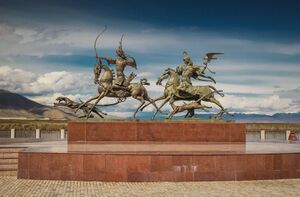
The obelisk, symbolizing the center of Asia, is located on the bank of the Yenisei River, in the city of Kyzyl of the Republic of Tuva. It was built three times — in 1964, 1984 and 2014. Today's monument is a whole sculptural ensemble. The new obelisk was built according to the project of the Buryat artist Dashi Namdakov. It is represented by an ensemble of three lions holding a globe topped with a spire. Externally, the monument is very similar to the previous obelisk. It depicts grandiose figures of oriental dragons and a high stele, the decor of which is made in the form of symbolic animals intertwined in a rush of ascent to the sky. In addition, people see twelve cosmogonic animalistic images that make up the Buddhist horoscope.
Ethnic and cultural complex of Aldyn-Bulak
It occupies the coastal zone of the Yenisei, to Kyzyl-45 km. It is built as a kind of model of the universe, where the roles of stars and luminaries are assigned to yurts of different sizes and purposes. Although the yurts are decorated as authentic as possible, Aldyn-Bulak has all the amenities, including places to stay, a restaurant, a sauna, a parking lot.
Tsechenling Temple
One of the most important Buddhist attractions of Kyzyl. Built in 1998, it consists of two floors: the first – as a residence, the second – for prayings. The corners of the building look more worn out, this is due to the tradition of walking around the temple in a circle and touching the corners. Classes on spiritual practices and languages are held inside, admission is free.
عجلة الصلاة البوذية
It was officially opened in 2006. It is considered the largest prayer wheel in Russia. It came from an Indian monastery, where the monks worked on the wheel for several years. Millions of scrolls with mantras are stacked inside.
Kadarchy Monument
It was installed in 1997 in front of the Kyzyl airport. The monument is a shepherd with a staff in traditional Tuvan clothing. After the sculpture took its place on the hill, the locals considered that the hero did not have enough liverstock, so "sheep" were placed nearby in the form of boulders painted white.
Mineral spring "Bobry"
It is located 2 kilometres or 1.2 miles from Kyzyl. The name is translated as "beavers": according to legend, people learned about the spring from these animals who came there to drink. There are more than 20 streams and springs, the water is collected in small natural and handmade bowls or spreads. According to legend, each of the streams treats different diseases, so tourists try the water from all of them.
National Museum of the Republic of Tyva
It was founded in 1929 in Kyzyl. Unique collections presented in the museum are: Archaeological collections of the Scythian mounds "Arzhaan" and "Arzhaan-2"; Tuvan ethnographic collections; Tuvan women's and men's silver jewelry; cult collections of Shamanism, Buddhism and Orthodoxy.
بحيرة دوس-خول
A salty spring in the Republic of Tuva. In the Tuvan dialect, the name of the reservoir means "salt lake". Dus-Khol is a natural monument and is under state protection. The water in this spring has healing properties. Throughout the summer season, tourists and locals come to the reservoir.
أحداث
المهرجان العالمي للموسيقى الحية والإيمان "Ustuu-Khuree"
The festival, which shows all the magnificence of indigenous cultures, has been held in the Republic of Tyva since 1999. The festival arose in line with the idea of restoring the ruins of a once majestic Buddhist temple in Chadan. The motto of the festival was live music and following the universal spiritual postulates of living faith (kindness, tolerance, unpretentiousness to the benefits of life).The simplicity of the living conditions of the tent city, the proximity to nature, the special atmosphere of the ruins of a Buddhist temple, the constant joint music playing of the participants — all these components created a unique image of the festival. Traditionally, the Ustuu-Khuree festival takes place in July.
المهرجان العالمي Khoomei في وسط آسيا"
The festival program traditionally includes competitions among throat singing performers, the consecration ceremony "Ovaa khoomei". It is held every two years. During the festival, the number of participants reached more than 600 people, including 31 foreign citizens from different countries, such as the US, China, Mongolia, Sweden, Germany, Japan, Brazil.
العطلة القومية "ناديم"
Naadym is a Tuvan national holiday of shepherds, held annually in mid-August. It necessarily includes the national wrestling khuresh, horse racing, archery, competitions for the best national yurt, the best national costume and equipment of a horse.
التعليم
- School No. 1 (Kyzyl) – first school in the city.[17]
- Tyvan State University – is the only university in Tyva.
في الثقافة الشعبية
In the late 1980s, Kyzyl was visited by Ralph Leighton, who had made it a quest to reach Tuva with his friend, the Nobel Prize-winning physicist Richard Feynman. Though Feynman died before they reached Tuva, the journey is chronicled in the book Tuva or Bust!
The film Genghis Blues chronicles the pilgrimage of a blind blues performer, Paul Pena, who learned Tuvan throat singing by listening to his shortwave radio, to compete in the Tuvan throat singing competition.
المدن الشقيقة
 Honolulu, Hawaii, United States[18]
Honolulu, Hawaii, United States[18] Rivne, Ukraine
Rivne, Ukraine Cuiabá, Mato Grosso, Brazil (both cities are claimed to be located in the exact center of their respective continents)
Cuiabá, Mato Grosso, Brazil (both cities are claimed to be located in the exact center of their respective continents) Erenhot، الصين
Erenhot، الصين ياقوتسك، روسيا
ياقوتسك، روسيا
المراجع
الهامش
- ^ أ ب ت ث ج ح خ Resolution #1648 ZP-1
- ^ Russian Federal State Statistics Service (2011). "Всероссийская перепись населения 2010 года. Том 1". Всероссийская перепись населения 2010 года (2010 All-Russia Population Census) (in Russian). Federal State Statistics Service. Retrieved June 29, 2012.
{{cite web}}: Invalid|ref=harv(help); Unknown parameter|trans_title=ignored (|trans-title=suggested) (help)CS1 maint: unrecognized language (link) - ^ أ ب ت Law #268 VKh-1
- ^ "Об исчислении времени". Официальный интернет-портал правовой информации (in Russian). 3 June 2011. Retrieved 19 January 2019.
{{cite web}}: CS1 maint: unrecognized language (link) - ^ Почта России. Информационно-вычислительный центр ОАСУ РПО. (Russian Post). Поиск объектов почтовой связи (Postal Objects Search) (in روسية)
- ^ invalid reference parameter
- ^ "Kyzyl city, Russia info, features, photos". russiatrek.org. Retrieved 2015-11-03.
- ^ "History of the city in the Center of Asia" v.1 (1914-1944) -Siberian Book Publishing House, 2013
- ^ newspaper "Plus Inform", No. 23, June 10, 2009, article "Belotsarsk-Uryankhaisk-Krasny-Kyzyl"
- ^ State Archives of the Republic of Tuva. R.M. Archimaeva (ed.). History of the city in the Center of Asia (Siberian book publishing house ed.).
- ^ State Archives of the Tyva Republic. R.M. Archimaeva (ed.). History of the city in the Center of Asia (Siberian Book Publishing House, 2013 ed.).
- ^ "Kyzyl". Encyclopædia Britannica. Retrieved 2007-07-30.
- ^ "Weather and Climate – The Climate of Kyzyl" (in الروسية). Weather and Climate (Погода и климат). Retrieved November 3, 2021.
- ^ "Kyzyl, Russia" (in الإنجليزية). Climatebase.ru. Retrieved January 24, 2013.
- ^ "Kyzyl". Bartleby.com. Archived from the original on أغسطس 11, 2007. Retrieved يوليو 30, 2007.
- ^ Недостаток средств, строителей и стабильности: когда же будет построена дорога Кызыл – Курагино?
- ^ Первой школе Кызыла - 95 лет
- ^ "UrbanPlanet.org - Giving cities a voice since 2003". Archived from the original on June 11, 2011. Retrieved June 11, 2011.
المصادر
- Законодательная палата Великого Хурала Республики Тыва. Постановление №1648 ЗП-1 от 21 декабря 2005 г. «Об утверждении реестра административно-территориального деления Республики Тыва», в ред. Постановления №455 ЗП-2 от 21 ноября 2007 г «О внесении изменения в реестр административно-территориального деления Республики Тыва». (Legislative Chamber of the Great Khural of the Tyva Republic. Resolution #1648 ZP-1 of December 21, 2005 On Establishing the Registry of the Administrative-Territorial Division of the Tyva Republic, as amended by the Resolution #455 ZP-2 of November 21, 2007 On Amending the Registry of the Administrative-Territorial Division of the Tyva Republic).
- Великий Хурал (парламент) Республики Тыва. Закон №268 ВХ-1 от 24 декабря 2010 г. «О статусе муниципальных образований Республики Тыва», в ред. Закона №837 ВХ-1 от 10 октября 2011 г. «О внесении изменений в Закон Республики Тыва "О статусе муниципальных образований Республики Тыва"». (الخورال الكبير (برلمان) جمهورية توڤا. Law #268 VKh-1 of December 24, 2010 On the Status of the Municipal Formations of the Tyva Republic, as amended by the Law #837 VKh-1 of October 10, 2011 On Amending the Law of the Tyva Republic "On the Status of the Municipal Formations of the Tyva Republic").
- Pages using gadget WikiMiniAtlas
- CS1 errors: unsupported parameter
- Articles with روسية-language sources (ru)
- CS1 الروسية-language sources (ru)
- Short description is different from Wikidata
- Articles with hatnote templates targeting a nonexistent page
- Infobox mapframe without OSM relation ID on Wikidata
- Coordinates on Wikidata
- Pages using infobox settlement with image map1 but not image map
- Articles containing روسية-language text
- Pages using Lang-xx templates
- Articles containing Tuvan-language text
- مقالات ذات عبارات بحاجة لمصادر
- جميع الصفحات التي تحتاج تنظيف
- مقالات بالمعرفة تحتاج توضيح from October 2019
- المقالات needing additional references from April 2022
- كل المقالات needing additional references
- عواصم جمهوريات روسيا
- Kyzyl
- 1914 establishments in the Russian Empire
- Populated places established in 1914
- Populated places on the Yenisei River
- صفحات مع الخرائط


